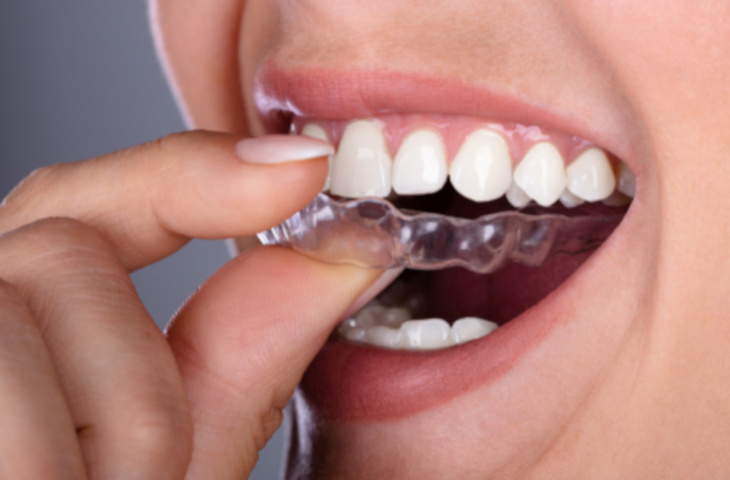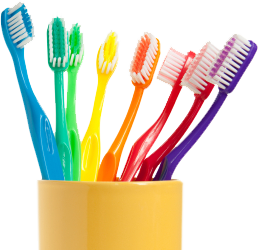
Whether or not you notice it, your teeth are on the move. Unless you wear a retainer regularly, your teeth are constantly shifting over time. Sometimes this leads to very visible gaps or overcrowding, and sometimes the effects are more subtle. Unfortunately, this is even true for people who had braces when they were young.
The good news is it is very easy to align teeth as an adult, and with clear-aligner orthodontics, you can straighten your teeth without anyone even noticing. Clear-aligner therapy is a popular and effective choice for many people who need orthodontic work but don’t want braces. With this pain-free system, ultra-thin plastic trays fit over you teeth and gradually move them into place. The trays are virtually invisible, and they can even be removed while you eat.
Using highly advanced 3D scanning technology, Dr. Sandhu can show you what you’ll look like after clear-aligner therapy is complete, so you’ll know where your teeth are going to end up before you even begin the process. If you’re not sure if you want or need to have your teeth straightened, Dr. Sandhu can scan your teeth once a year to show you exactly how much your teeth are shifting over time.
Whether you work in the public eye, or simply don’t like the look of conventional braces, aligner therapy is an option worth considering.
COMMON QUESTIONS ABOUT CLEAR ALIGNERS
What are clear aligners
Clear-aligner therapy is a modern alternative to traditional metal braces. Using this system, patients go through a series of clear plastic trays that gradually move crooked teeth into alignment. The trays are designed specifically for each individual so they fit perfectly over your teeth every step of the way.
What kind of issues do clear aligners help with?
Clear aligners are effective at fixing a number of dental spacing problems, including crowding, gaps between teeth, overlapping teeth, overbites, and underbites. They are especially helpful for people who had braces as a child but stopped wearing a retainer at some point. In those cases, people can experience relapse, in which their teeth eventually move back to where they started.
Straightening teeth is not purely cosmetic, it’s functional too. People with crowded or overlapping teeth experience more plaque buildup and are susceptible to gum problems, no matter how well they brush. Aligning teeth can also help prevent grinding and clenching, which can be helpful for people with temporomandibular joint dysfunction, or TMJ. In addition, clear aligners act as nightguards, so people who grind or clench will be protected from further damage during therapy.
Are clear aligners the same as Invisalign?
Yes, all clear aligners, including Invisalign, are essentially the same. Invisalign is the name of one lab that manufactures clear aligners. However, there are other labs that do the exact same thing, while charging dentist offices less money for their services. Dr. Sandhu uses one of these other labs and is able to pass those savings on to patients.
With these clear aligners, you can expect the same process, the same product, and the same results as you would get from Invisalign.
Are clear aligners as effective as braces?
Yes, in most cases, clear aligners are just as good as traditional metal braces—and they have the added benefit of being virtually unnoticeable, which appeals to many adults. In some rare, more extreme cases, metal braces might be necessary. But clear aligners are a great option for most people who want to straighten their teeth.
How does clear-aligner treatment work?
Before starting alignment treatment, Dr. Sandhu will address any active cavities or infections and make sure you have an up-to-date cleaning. We’ll then start the process by taking a scan of your teeth with an iTero intraoral 3D scanner. This advanced process takes only 5-10 minutes, and it eliminates the need for taking traditional impressions with goop that many people find distasteful. The digital scans are then submitted to a lab that fabricates the clear trays specifically for your teeth.
The first tray arrives about three weeks after the initial scan. You’ll come back into the office to pick up your first tray and to learn how to use them. At this point, we’ll place tiny, temporary buttons on your teeth for the trays to adhere to. These buttons are tooth-colored, so they’re not visible, and they are removed once the process is done.
You’ll wear your tray for 22 out of 24 hours each day, only taking them out to eat. Each tray is worn for two weeks, then it’s switched out for the next tray. Once you get the hang of it, we’ll give you several trays at once, so you only need to see the dentist every 6 to 10 weeks. Dr. Sandhu can combine these follow-up visits with your regular check-ups and cleanings in order to maximize your time.
How long does clear-aligner treatment take?
The length of treatment will vary, depending on every individual situation. But most people only require treatment for 6 months to a year and a half. More-involved cases might require two years of treatment. Dr. Sandhu will be able to give you an accurate estimate during a consultation. At the end of treatment, Dr. Sandhu recommends that patients wear a retainer to keep their teeth properly aligned for good.
Is the clear-aligner orthodontics process painful?
No, using clear aligners for teeth straightening is not painful, and the most common side effects tend to happen early on. For example, when patients switch to a new tray, they might feel a small amount of discomfort as they adjust to the new fit. Some people notice that it can affect their speech at the beginning of the process, but that typically goes away once they get accustomed to it.
Are clear aligners covered by insurance?
Coverage varies from plan to plan, so your coverage will depend on your dental insurance plan. Coverage for clear-aligner treatment is the same as for regular orthodontia, so if regular braces are covered by your insurance plan, the clear aligners will be covered too. In addition, Dr. Sandhu offers CareCredit, with up to 12 months of no interest, and many of her clear-aligner therapy patients opt for that. Patients can also use their FSA or HSA plans for this type of treatment.

